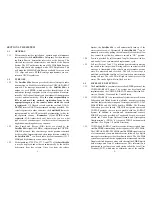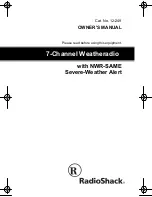
recommended.
2.1.5
Do not mount the Satellite 406
TM
in the vicinity (2 meters) of
strong magnetic (such as loud speakers) or electric (such as radar
or high power radio transmitter) fields.
2.1.6
Consideration should be given to mounting the Satellite 406
TM
in a
vertical (antenna upward position). In certain circumstances, such
as medical emergencies or disabled vessels, manual activation of
the EPIRB for location and homing purposes is sometimes re-
quested. Mounting in this orientation provides the best homing
signal.
2.2
VISUAL INSPECTION
2.2.1
Visually inspect the area surrounding the mounting bracket instal-
lation site for hidden hazards, obstacles, etc., that may have been
overlooked during selection. If there is any doubt as to the ready
accessibility to the beacon at all times or if any condition may
appear to be questionable, make complete and thorough investiga-
tion before making final approval of the installation.
SECTION 3 - OPERATION
3.1
GENERAL
3.1.1
The
Satellite 406
TM
Beacon Models 2754, 2756, 2772, and 2773
are designed to be automatically deployed and activated. The
Satellite 406
TM
may also be hand held on the deck of vessels, or
floated in water and attached to a raft or life vest with the lanyard
provided. The
Satellite 406
TM
is designed to operate best while
floating in water. Hand held operation should be avoided when
possible. Do not operate inside liferaft or under any similar cover
or canopy.
3.1.2
The
Satellite 406
TM
Beacon can be deployed and activated
manually in any of the available products.
3.1.3
Because many users failed to properly place earlier generation
beacons in the ARMED or READY positions when install-
ing them in their brackets, U.S. and International specifications
require the elimination of the OFF switch position and the
inclusion of sensors to automatically activate the beacon under
specific conditions.
The
Satellite 406
TM
is equipped with sensors to detect when it is
no longer in its bracket (a deployment condition) and other
sensors to determine if its in water.
Two conditions must be satisfied for the
Satellite 406
TM
to
automatically activate:
1) It must be out of its bracket,
2) It must be in the water,
Note: Either condition by itself will
not
activate the beacon.
3.1.4
The
Satellite 406
TM
is also designed to allow the user to perform
periodic testing while EPIRB is in the release bracket to assure a
functioning beacon.
3.1.5
Place the
Satellite 406
TM
Product No's 2754 and 2756 into the
release bracket with the coiled lanyard inward. Fold the capture
arm over the beacon and onto the release rod eyelet. Place the
retaining pin through the eyelet. The beacon should now be firmly
held in the release bracket and ready for automatic deployment.
3.2
AUTOMATIC DEPLOYMENT & DEACTIVATION
(Product No's 2754 & 2756 only)
3.2.1
Automatic deployment and activation occurs when the vessel
sinks and a hydrostatic release device frees the beacon from the
bracket allowing it to float to the surface. Built-in sensors detect
that the beacon is no longer in its bracket and is in water. This
condition will automatically activate the beacon.
Note: Transmissions of the 121.5 MHz signal will begin
immediately while the first 406 MHz transmission will not occur
until 50 seconds later.
3.3
MANUAL DEPLOYMENT & ACTIVATION
3.3.1
The
Satellite 406
TM
can be manually deployed by removing the
retaining pin, then removing the beacon from the mount.
It is best
to hold one hand against the beacon when removing the retaining
pin to prevent the ejector spring from tossing the beacon
. Once
removed from the bracket, the beacon can be activated by placing
it in water or by pulling the red lanyard to break the yellow key,
remove the yellow key and move switch to ON position.
Note: Activating the beacon by removing the yellow blocking
key will cause a tear in the end of the key. Some countries fine
vessel owners for causing false alarms. The permanent change
to the blocking key is a positive indicator of a manual activation.
- 7 -
- 8 -




























